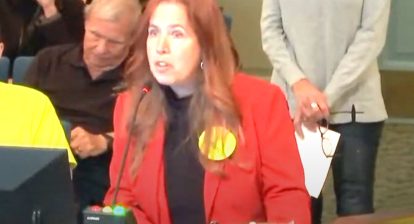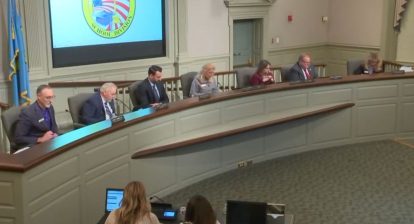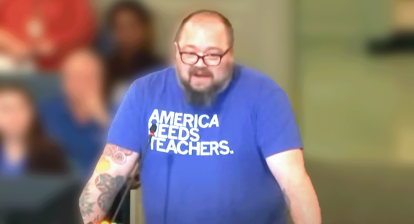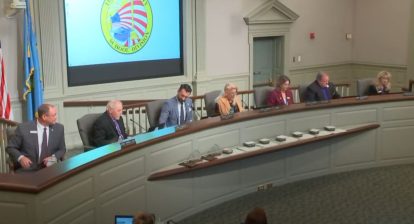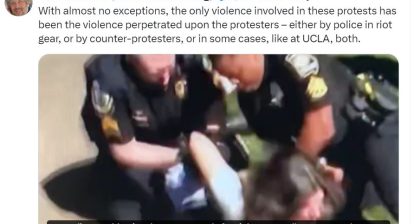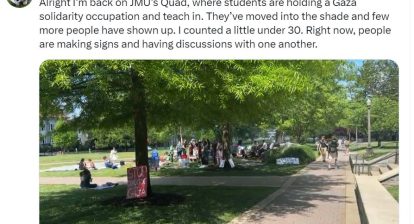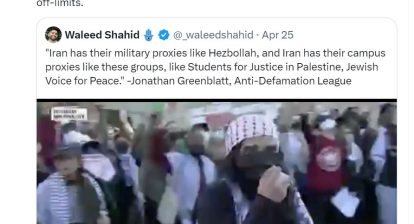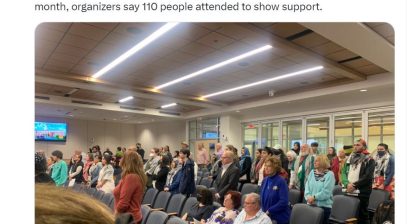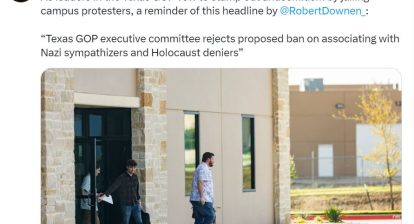Location: York County, VA
Author: Brian Reese, Digital Producer, WAVY.com news organization
Date: February 23, 2024
Title: Alleged militia actions in York County may lead to ‘democratic erosion,’ expert says
Key Points Summary (based on the text of this article):
In York County, Virginia, the involvement of a newly formed militia group in school board events has sparked significant community concern.
Allegations arose that York County School Board Chair Lynda Fairman sent the militia to film a Family Life Education event, which she denies, claiming her call was to the general public. The militia also denies filming or attending on Fairman’s behalf.
Carolyn Gallaher, from American University, expresses concerns about militias appearing in public spaces, suggesting it could be intimidating and contribute to democratic erosion.
Gallaher’s piece, “County Capture,” discusses the influence of militia groups in Virginia, highlighting their potential to disrupt democracy at the local level through intimidation and influence over government officials and law enforcement.
She notes that some militias have attempted to rebrand as civic groups, focusing on community service, yet the underlying issue of armed paramilitary groups operating at a local level remains problematic.
Local law enforcement, including York-Poquoson Sheriff Ron Montgomery, has distanced themselves from endorsing or supporting militia activities, emphasizing the legal and societal risks involved.
Gallaher raises concerns about the potential for conflict between militias and law enforcement, the unvetted nature of militia members, and the increased partisanship within militia movements, particularly their support for the Republican Party after Donald Trump’s presidency.
The article warns of the dangers militias pose to democracy, including intimidation of voters, harassment of election workers, and the potential for violence in political disputes.
Political Analysis of the WAVY 10 Article (from the perspective of the written words in this article):
Lynda Fairman: Chair of the York County School Board, accused of mobilizing a militia group to monitor a Family Life Education event. She denies direct involvement with the militia, stating her call was for the general public to attend the event.
Carolyn Gallaher: Chair of the Department of Peace, Human Rights & Cultural Relations at American University. She provides expert commentary on the potential threat posed by militia groups to democratic processes and public safety. Gallaher highlights concerns about democratic erosion and the problematic nature of militia groups engaging in civic activities while maintaining their armed status.
Bob Herget: Identified as the leader of the York County Poquoson Constitutional Militia. He represents the militia’s perspective, denying filming at the event and indicating the group’s shift towards community service projects, yet maintaining a militia identity.
Ron Montgomery: Sheriff of York-Poquoson, who expresses disapproval of militia groups and their self-identification as such within the county. His perspective underscores law enforcement’s cautious stance on formal or informal cooperation with militias, given the legal and social implications.
Stewart Rhodes: Leader of the Oath Keepers, convicted of seditious conspiracy in relation to the Jan. 6 insurrection. His mention underscores the broader national context of militia movements and their potential impact on political stability and public trust in democratic institutions.
Donald Trump: Former U.S. President, indirectly related to the discussion through the article’s exploration of militia groups’ partisan activities and alignment with Trump’s political agenda, particularly in the context of the Jan. 6 insurrection and the broader politicization of militia activities.
Proud Boys: A self-declared militia group, mentioned for their involvement in political events supporting Trump. Their activities exemplify the growing concern over militia groups’ participation in political processes and the potential for these groups to influence or disrupt democratic norms.
These individuals and groups were used as a central theme in this Brian Reese article to establish spurious connections that are being used to manipulate public opinion against the School Board, and the Sheriff’s office. This author is attempting to impugn these individuals with these alleged connections to establish a public mindset that is central to understanding the author-fabricated dynamics at play in York County and the broader implications for democracy and public safety. The analysis also shows that there is collateral damage being done to the overall reputation, institutions, government, businesses, and culture of York County by pointing out an alleged tension between community service initiatives by militia groups and their potential to intimidate or exert undue influence on public and political processes.
Political Bias Analysis of the WAVY 10 Article (based on the text of this article):
Lynda Fairman: As the York County School Board Chair accused of having connections with a militia group, her political bias might lean towards conservative or right-leaning ideologies, especially if the allegations about her encouraging militia attendance at a school event hold any truth. Her denial and framing of the call to the public can be seen as an attempt to distance herself from direct militia affiliations while still engaging with conservative activism.
Carolyn Gallaher: An academic focusing on peace, human rights, and cultural relations who criticizes militia groups’ involvement in local politics and their potential threat to democracy. Gallaher’s analysis and concerns about democratic erosion suggest a liberal or left-leaning bias, emphasizing the dangers of armed groups in civil society and their impact on democratic institutions.
Bob Herget: Identified as the leader of the “York County Poquoson Constitutional Militia,” his actions and the group’s involvement in community activities under the guise of civic engagement indicate a bias towards right-wing militia ideologies. This bias includes a blend of community service with readiness for paramilitary activities, reflecting a conservative stance emphasizing Second Amendment rights and local governance.
Ron Montgomery: The York-Poquoson Sheriff’s disapproval of the militia group and his commitment to professional law enforcement practices suggest a bias towards moderate or centrist principles. His focus on public safety and legal frameworks indicates a preference for traditional law enforcement methods over paramilitary involvement in community affairs.
Stewart Rhodes & Proud Boys: These figures and groups are associated with far-right ideologies, emphasizing a strong bias towards conservative and right-wing political actions. Their involvement in events like the Jan. 6 insurrection and support for Donald Trump reflects a commitment to extreme conservative agendas, including anti-government sentiments and loyalty to specific political leaders over democratic principles.
Donald Trump: The former President is a central figure for right-wing and conservative movements, including militia groups. His presidency and actions have significantly influenced these groups, indicating his bias towards promoting conservative ideologies, challenging democratic norms, and supporting or inspiring paramilitary activities aligned with his political interests.
These biases reflect the individuals’ and groups’ political orientations and actions within the context of the article, highlighting the spectrum of political ideologies from conservative to liberal, and their impact on local and national politics.
Perception Analysis of the WAVY TV 10 Article (based on the text of this article):
Lynda Fairman:
Perceived by Conservatives: As a defender of traditional values, especially if they believe her actions are in line with protecting community interests against perceived liberal policies in education.
Perceived by Liberals: May view her with suspicion or as an antagonist, especially if they interpret her call to the public as a tacit endorsement of militia involvement in school affairs.
Carolyn Gallaher:
Perceived by Academic and Liberal Communities: As an informed critic highlighting the dangers of militia involvement in local politics, contributing valuable insights into the erosion of democratic practices.
Perceived by Militia Supporters and Conservatives: Potentially viewed as biased against conservative groups, possibly interpreting her analysis as an overreaction or misunderstanding of their intentions.
Bob Herget:
Perceived by Militia and Conservative Supporters: As a community leader who is taking proactive steps to engage in civic activities while upholding constitutional rights, embodying a patriotic stance.
Perceived by Critics and Liberals: As misrepresenting the nature of militia activities under the guise of community service, raising concerns about the potential for intimidation and undemocratic influences.
Ron Montgomery:
Perceived by General Public and Law Enforcement: As a voice of reason and professionalism, prioritizing public safety and legal boundaries over partisan politics or extrajudicial activities.
Perceived by Militia Groups: Depending on their stance, as either an ally in maintaining order or an obstacle to their broader goals of community engagement and self-determination.
Stewart Rhodes & Proud Boys:
Perceived by Far-Right and Some Conservative Circles: As champions of conservative causes, willing to take bold actions to defend their views against perceived threats from the left.
Perceived by Liberals, Centrists, and Critics: As embodying extremist ideologies that threaten public safety and democratic institutions, with actions that undermine the rule of law and social cohesion.
Donald Trump:
Perceived by Supporters: As a figurehead of the conservative movement, whose presidency was a high point for right-wing policies and actions, including empowering militia groups.
Perceived by Opponents and Critics: As a divisive figure whose rhetoric and policies have emboldened extremist groups and contributed to political polarization and challenges to democratic norms.
These perceptions highlight the polarized views surrounding the actions and statements of the individuals and groups involved in this article by Brian Reese in his attempt to establish broader societal divisions in York County over issues of governance, public safety, and the role of militias in American politics.
Sentiment Analysis of the WAVY 10 news article (based on the text of this article):
The sentiment analysis of the article’s content, focusing on the reactions and implications associated with the actions of individuals and groups mentioned, can be summarized as follows:
Lynda Fairman:
Negative Sentiment: Concern and disapproval from community members and critics who view her alleged actions as fostering divisiveness and potentially endorsing the involvement of militia groups in educational settings.
Ambiguous Sentiment: From those who may support increased community involvement in education but are wary of the methods or implications of calling on militia groups for such involvement.
Carolyn Gallaher:
Positive Sentiment: Appreciation and respect from those who value academic insights into the dynamics of militias and their impact on democracy, viewing her analysis as a crucial warning against the dangers of armed groups in civic spaces.
Negative Sentiment: Skepticism or hostility from militia supporters or those who view her stance as an exaggeration or mischaracterization of militia activities.
Bob Herget:
Positive Sentiment: Support and approval from within his militia group and like-minded individuals who see the group’s actions as positive community engagement and a stand for constitutional rights.
Negative Sentiment: Alarm and criticism from opponents who view the militia’s presence and actions as inappropriate or threatening, particularly in the context of educational events.
Ron Montgomery:
Positive Sentiment: Commendation from those who value the adherence to legal and professional standards in law enforcement, appreciating his stance against endorsing or supporting militia groups.
Mixed Sentiment: From some community members who might value militia involvement in certain capacities but agree with Montgomery’s concerns about official endorsement and potential conflicts.
Stewart Rhodes & Proud Boys:
Negative Sentiment: Widespread condemnation from those opposed to extremist ideologies and actions that threaten public safety and democratic processes, viewing these groups as embodying far-right extremism.
Positive Sentiment: Support from their respective followers and those aligned with their political views, who see their actions as defending American values and freedoms against perceived threats.
Donald Trump:
Positive Sentiment: Strong support from followers and those who align with his political ideologies, viewing his presidency and rhetoric as a catalyst for positive change and empowerment of conservative movements.
Negative Sentiment: Significant opposition from critics who view his influence as divisive and detrimental to societal cohesion and democratic norms, particularly in relation to his perceived encouragement of militia groups.
This sentiment analysis reflects the complex and polarized reactions elicited by incomplete and selective actions and statements of the individuals and groups involved. Brian Reese and Carolyn Gallaher use associative techniques in this article between groups and places outside of York County in an attempt to establish inaccurate and clear divides between York County support and opposition based on political ideologies and perspectives on public safety, governance, and community involvement.
Yellow Journalism Analysis (based on the text of this article):
Sensationalism and Exaggeration:
The summary indicates the use of overly dramatic or sensational language. It misrepresents concerns from community members and experts about the presence and actions of a militia group, which are based on a small number of samples.
Accuracy and Fair Representation:
The summary mentions specific individuals by name and their statements or positions regarding the event. The accuracy of the allegations was not fact-checked with evidence to support the sensational byline of the article along with organizational links between individuals and the organizations mentioned. The fairness of the representation would also depend on whether the article provides space for all relevant perspectives, including those of the militia group, school board chair, and law enforcement. In this case, one perspective from an academic from a liberal university with no connections to York County or its citizens was used to establish nonexistent links between citizens and elected school board members and these organizations.
Emotional Appeal Over Facts:
While the subject matter is inherently emotive due to concerns about community safety, democracy, and the role of militias, the summary appears to prioritize emotional appeal over factual reporting. It cites concerns from a department chair at American University which suggests an attempt to sensationalize and validate the discussion with expert and authoritative opinions.
Reliance on Unverified Sources:
The information provided indicates a reliance on unverified sources. Although it references public figures and a sheriff, the academic expert makes direct statements about York County based on anecdotal stories and inferences from the local, state, and national levels which is being coached by the reporter.
Purpose and Intent:
The intent behind the article, as summarized, seems to be highlighting a contentious issue within the community related to the actions of a militia group and its implications for democratic processes and public safety. There appears to be a deliberate attempt to mislead, provoke undue controversy, or push a specific agenda without basis.
Based on these considerations, the article, as summarized, clearly exhibits the hallmarks of Yellow Journalism. It appears to focus on potentially insignificant and fabricated issues and provides slanted viewpoints from different sides of the debate. From its tone, language, and the completeness of its coverage, this assessment can only be provisional. However, based on the summary provided, the article seems to aim more towards indulging in sensationalism and misinformation.


